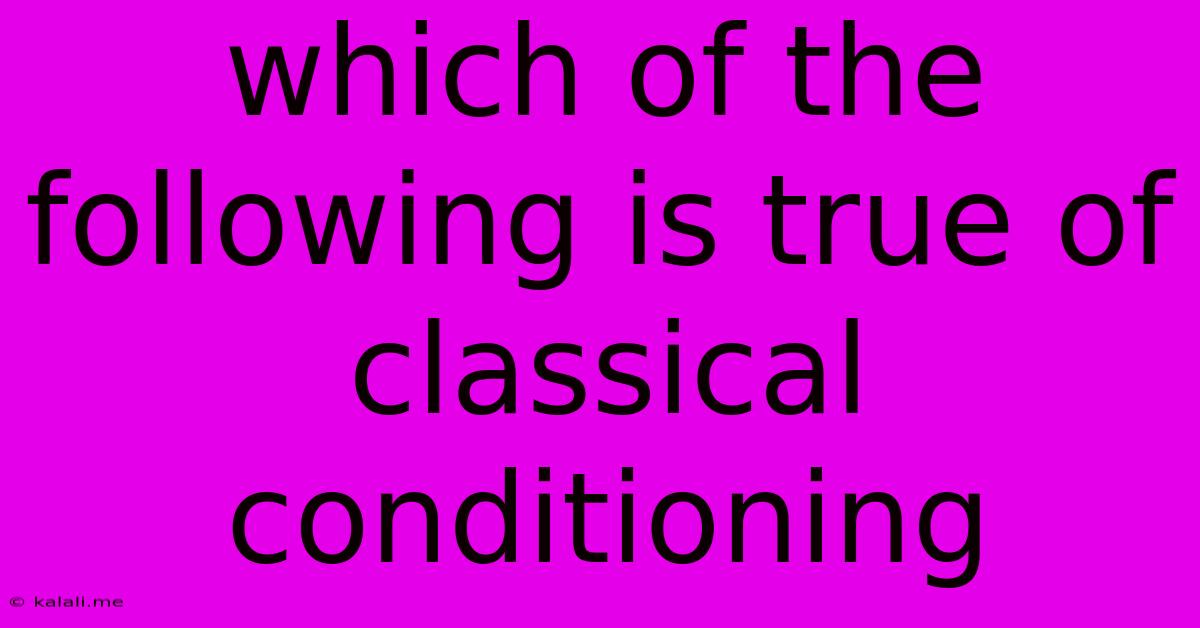Which Of The Following Is True Of Classical Conditioning
Kalali
Jun 14, 2025 · 3 min read

Table of Contents
Which of the Following is True of Classical Conditioning? Deconstructing Pavlov's Legacy
Classical conditioning, a fundamental concept in behavioral psychology, continues to fascinate and inform our understanding of learning. This article explores the core principles of classical conditioning, addressing common misconceptions and clarifying its key characteristics. Understanding this learning process is crucial for anyone studying psychology, education, or animal behavior. We'll unpack what truly defines classical conditioning and debunk some common misunderstandings.
Classical conditioning, initially demonstrated by Ivan Pavlov with his famous dog experiments, involves learning through association. A neutral stimulus becomes associated with a naturally occurring stimulus (unconditioned stimulus) that triggers an automatic response (unconditioned response). Through repeated pairings, the neutral stimulus eventually elicits a similar response (conditioned response) on its own, becoming a conditioned stimulus.
Key Characteristics of Classical Conditioning:
-
Association: The core principle is the association between a neutral stimulus and an unconditioned stimulus. This repeated pairing creates a learned association in the mind of the learner. The strength of this association dictates the strength of the conditioned response.
-
Unconditioned Stimulus (UCS): This is a stimulus that naturally and automatically triggers a response without prior learning. In Pavlov's experiment, the food was the UCS.
-
Unconditioned Response (UCR): This is the natural, unlearned response to the unconditioned stimulus. The dog's salivation to the food was the UCR.
-
Conditioned Stimulus (CS): This is initially a neutral stimulus that, after repeated pairing with the UCS, comes to elicit a response. The bell, initially neutral, became the CS after being repeatedly paired with the food.
-
Conditioned Response (CR): This is the learned response to the conditioned stimulus. The dog's salivation to the bell alone is the CR. It's similar to the UCR, but learned through association.
-
Extinction: If the conditioned stimulus is repeatedly presented without the unconditioned stimulus, the conditioned response gradually weakens and eventually disappears. This is extinction.
-
Spontaneous Recovery: After extinction, the conditioned response may reappear spontaneously if the conditioned stimulus is presented again after a period of time. This demonstrates that the learned association isn't completely erased.
-
Stimulus Generalization: Once a conditioned response is established, similar stimuli to the conditioned stimulus may also elicit the conditioned response, although usually to a lesser degree. For example, a dog might salivate to a chime similar to the bell.
-
Stimulus Discrimination: The ability to differentiate between the conditioned stimulus and other similar stimuli, preventing generalization. The dog learns to only salivate to the specific bell, not other sounds.
Common Misconceptions about Classical Conditioning:
-
It only applies to animals: While Pavlov's research used dogs, classical conditioning principles apply equally to humans. Many aspects of human learning, from phobias to preferences, can be explained through classical conditioning.
-
It's solely about involuntary responses: While many examples involve involuntary responses like salivation, classical conditioning can also influence voluntary behaviors. This is particularly evident in the context of emotional responses.
-
It's a simple, one-time process: The strength of the conditioned response depends on the number of pairings between the UCS and CS, the timing of these pairings, and the intensity of the stimuli.
In Conclusion:
Classical conditioning is a powerful learning mechanism based on the association of stimuli. Understanding its principles—association, extinction, spontaneous recovery, generalization, and discrimination—provides crucial insight into how learning occurs, not just in animals but also in humans. By dispelling common misconceptions and highlighting its key characteristics, we can appreciate the enduring significance of Pavlov's legacy in the field of psychology.
Latest Posts
Latest Posts
-
A Right Triangle Has Legs With Lengths Of 24 Centimeters
Jun 15, 2025
-
How Many Unknown Reactions Does The System Have Figure 1
Jun 15, 2025
-
The Preferred Method For Thawing Food Is
Jun 15, 2025
-
An Instrument Used For Visual Examination Of The Ear Is
Jun 15, 2025
-
What Are The Three Forms Of Water
Jun 15, 2025
Related Post
Thank you for visiting our website which covers about Which Of The Following Is True Of Classical Conditioning . We hope the information provided has been useful to you. Feel free to contact us if you have any questions or need further assistance. See you next time and don't miss to bookmark.